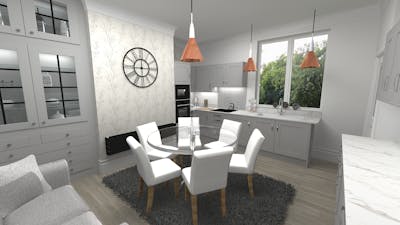10 L-Shaped Kitchen Ideas | More Kitchens
Published: 25 November 2019 · Last Updated: 2 June 2023
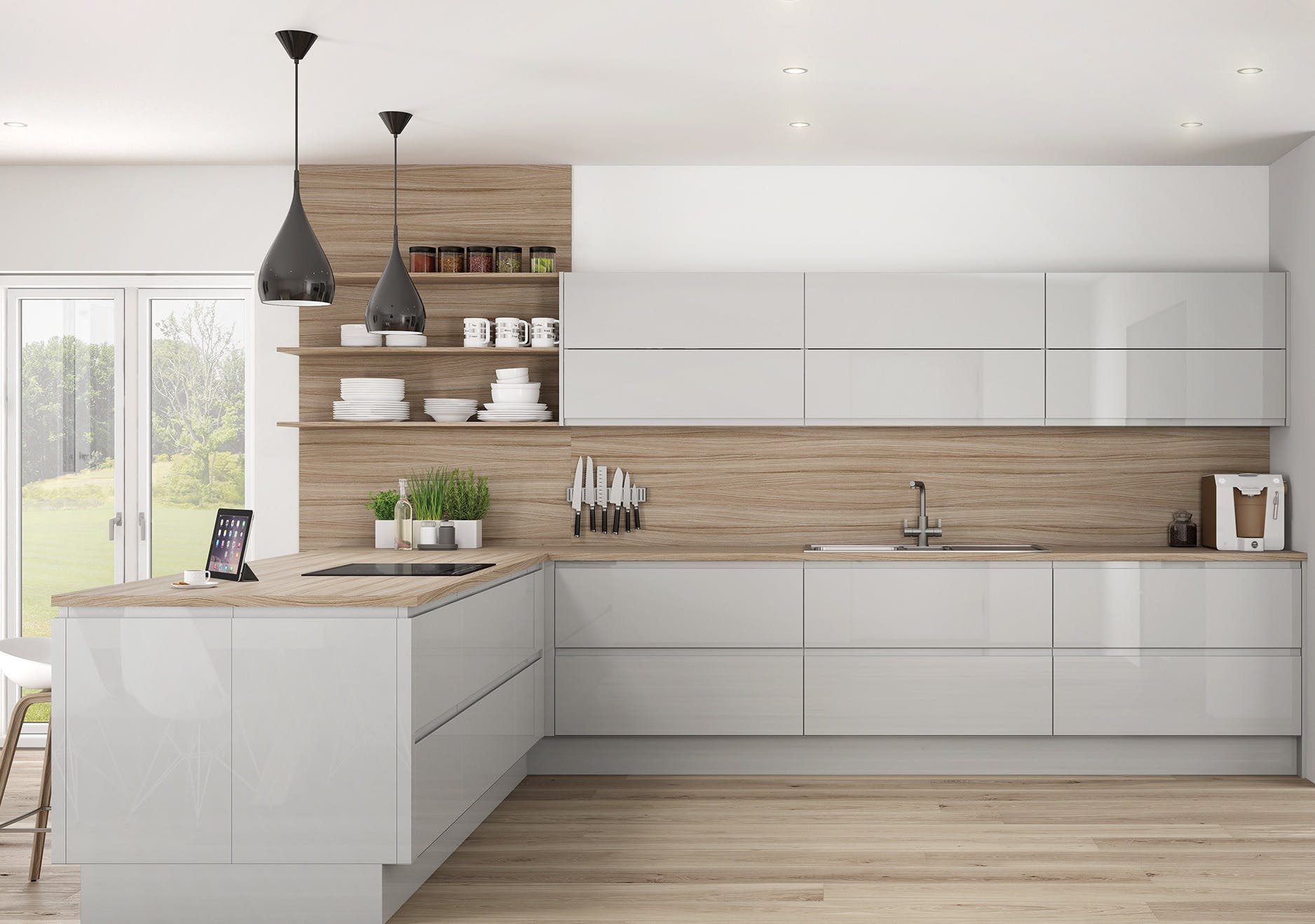
Flexible, functional, and seamlessly incorporated into almost any size or shaped kitchen - whether that be open or closed-planned - it is easy to see why L-shaped kitchen designs are growing in popularity.
We all aspire to have a kitchen that lives and breathes and is efficient, with room to move and appreciate the space. L-shape kitchens have the ability to take on many different styles that matches our lifestyle and inspires us and encourages social interaction.
The L-shape kitchen design, with its worktops adjoining walls that meet in one corner, stands apart in the market for maximising room efficiency and functionality, providing more floor space than its U-shaped alternative without sacrificing the worktop real estate.
It can also be a hive for creativity, allowing for a host of styles, colours, materials, appliances, and finishes. So, if you’re thinking about incorporating an L-shaped design but are not sure where to start, read on for our team’s top 10 design tips.
Firstly, What is an L-shaped kitchen
As of May 2023, Google shows there has been a 29% increase in the number of searches in the UK for ‘L-shaped kitchen designs’ in the past year.
But what is an L-shaped kitchen design?
L-shaped kitchen designs feature two walls that form a 90-degree angle, with cabinets and appliances installed along these walls. They use work surfaces, cabinets, and appliances within the layout to maximise space.
This makes L-shaped kitchens a great choice for small spaces, open-plan spaces, and also kitchens incorporating an island.
It’s also different from a U-shaped or Peninsula kitchen design, as with these popular kitchen layouts three out of the four sides to a surface are flush to a wall, therefore only accessible from one side.
And what are the benefits of a L-shape kitchen?
The L-shape design for the kitchen is particularly useful for spaces that are relatively small and when you need to make the most of the space you have, being particularly practical for those who need to maximise their storage space, as the two sides of the “L” create plenty of room for cabinets, shelves, and appliances.
In addition, L-shaped kitchens offer increased workspace and create an efficient ‘work triangle’ between the sink, refrigerator, and stove. The angled design also makes it easy to access everything within the kitchen without having to move too far.
Lastly, there is the aesthetic to factor in here. L-shaped kitchens just look great and have the capability to add a lot of character and style to even the smallest of spaces.
Our top 10 design tips for L-shaped kitchens
From maximising worktop space to choosing the right blend of colours and finishes, there are numerous ways to approach an L-shape kitchen design to get it just right for you and your lifestyle.
Our team of senior kitchen designers has pooled together their top 10 design tips, while a little later, we will look at some of the popular types of L-shaped kitchens you can choose from.
Let’s dive straight in!
1. Adding more efficiency with a breakfast bar
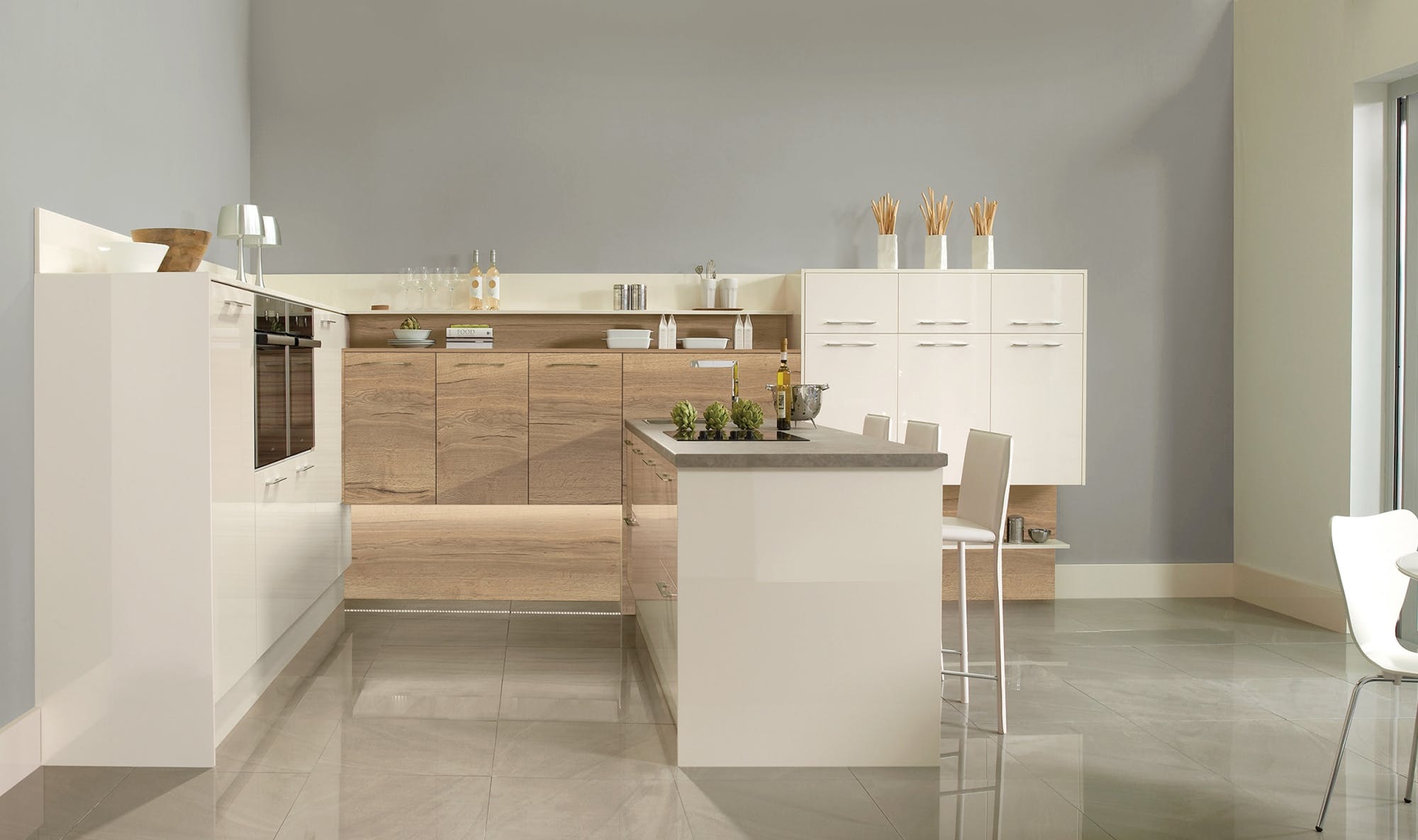
The term breakfast bar doesn’t do the product itself justice.
Not only does a breakfast bar create a more visually appealing space, but they also add a practical element that can be used for both meals and homework. The breakfast bar acts as a natural divider between the kitchen and other living quarters, giving the kitchen its own space to thrive while also allowing for a more open and spacious feel.
Additionally, it can double as an eating area for larger groups, perfect for when you are getting into host mode and you have guests coming over. Breakfast bars can also provide extra counter space for food preparation, making cooking far more efficient.
Similarly, you could consider an island that will enhance this further while creating a focal point for the room and enhancing the overall aesthetic.
2. Maximising your corners to create more space
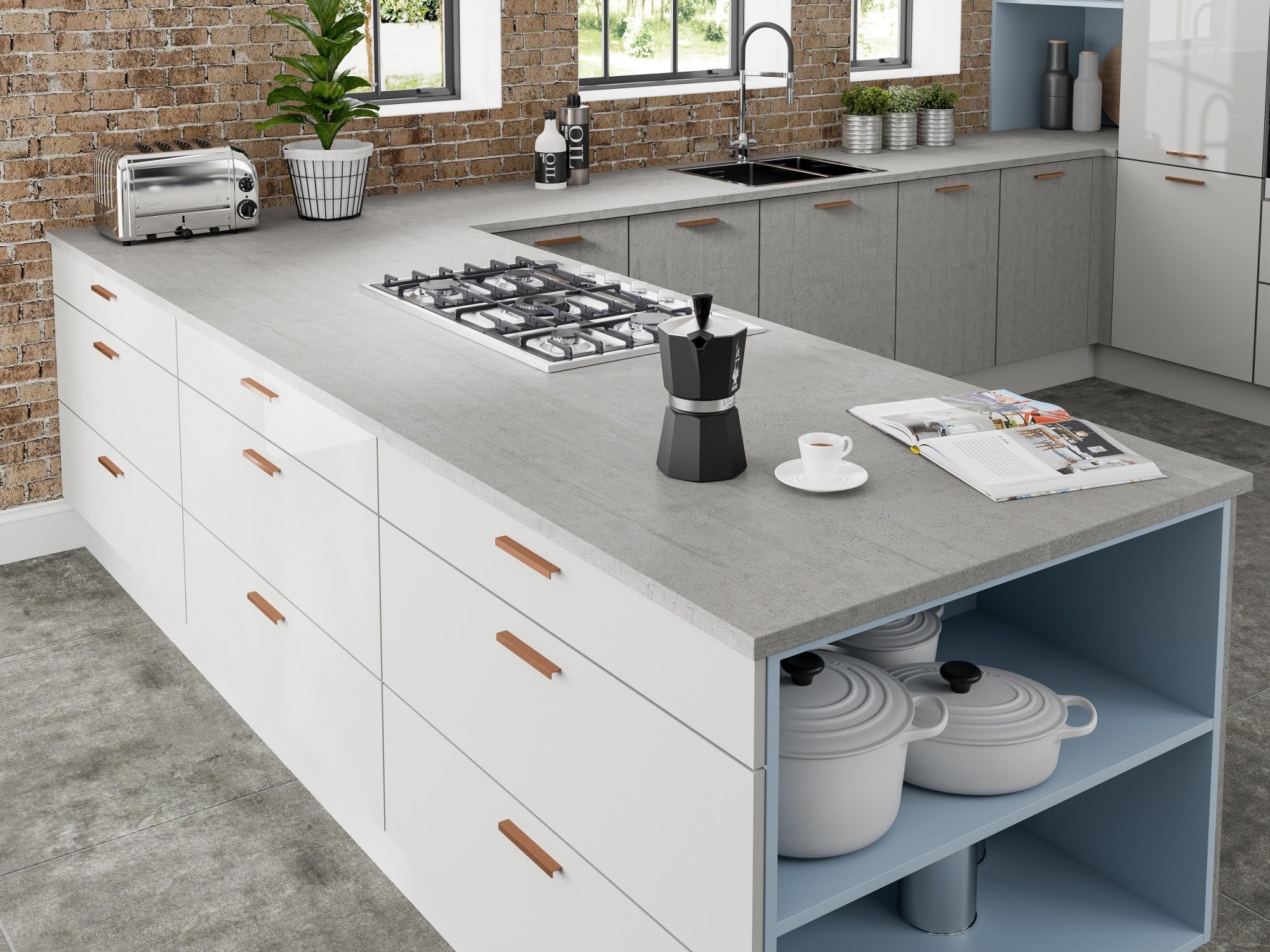
Believe it or not, corner space is an often overlooked area in kitchen design, but is one that can make a huge impact on the overall space, maximising what is available and creating a more functional and aesthetically pleasing kitchen.
Corner cabinets can be used to store a variety of items, from large appliances to extra dishes and cutlery. It doesn’t have to all be about hiding things away, though. Corner cabinets and shelving can act as great display features to bring your personality to the table.
From space-saving to space-enhancing, valuable corner space can also be used to create a breakfast nook or a small seating area.
3. Nothing says you like a pop of colour
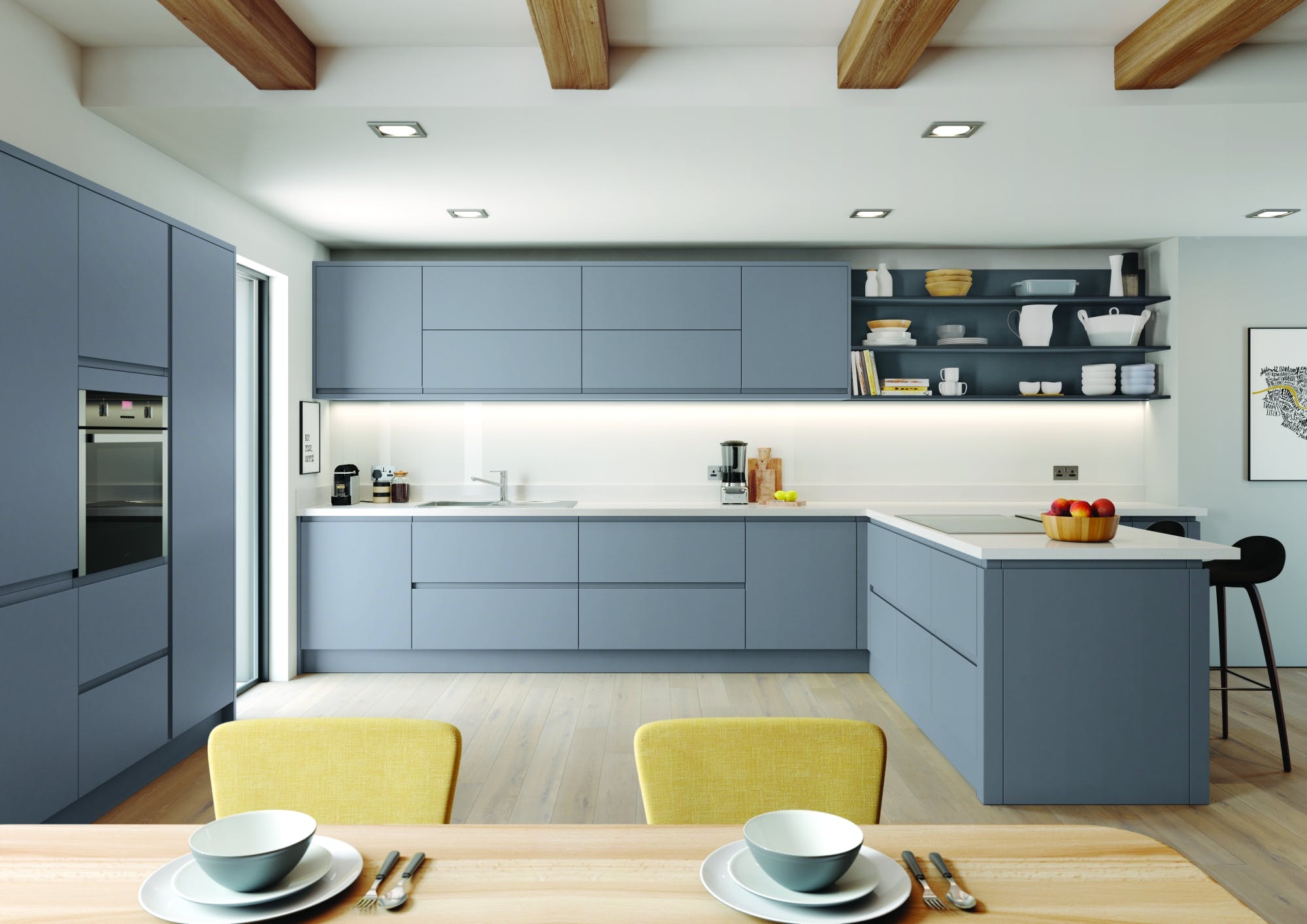
Bold colours can create a sense of energy and vibrancy in what can sometimes be a smaller and more confined kitchen space.
And by incorporating bright and vibrant colors, you can make your kitchen feel more spacious and inviting. It can be used to create focal points that draw attention to certain areas of the kitchen, allowing you to create a unique and stylish look.
If going bold isn’t your style, contrasting colours, in equal measure, can make a huge impact, enabling each area to stand out and making it easier to distinguish between them. Contrasting colours - like red and green or orange and blue - help bring a sense of organisation and structure to the kitchen, making it feel more spacious and comfortable.
4. Create interesting and eye-catching designs with open shelving
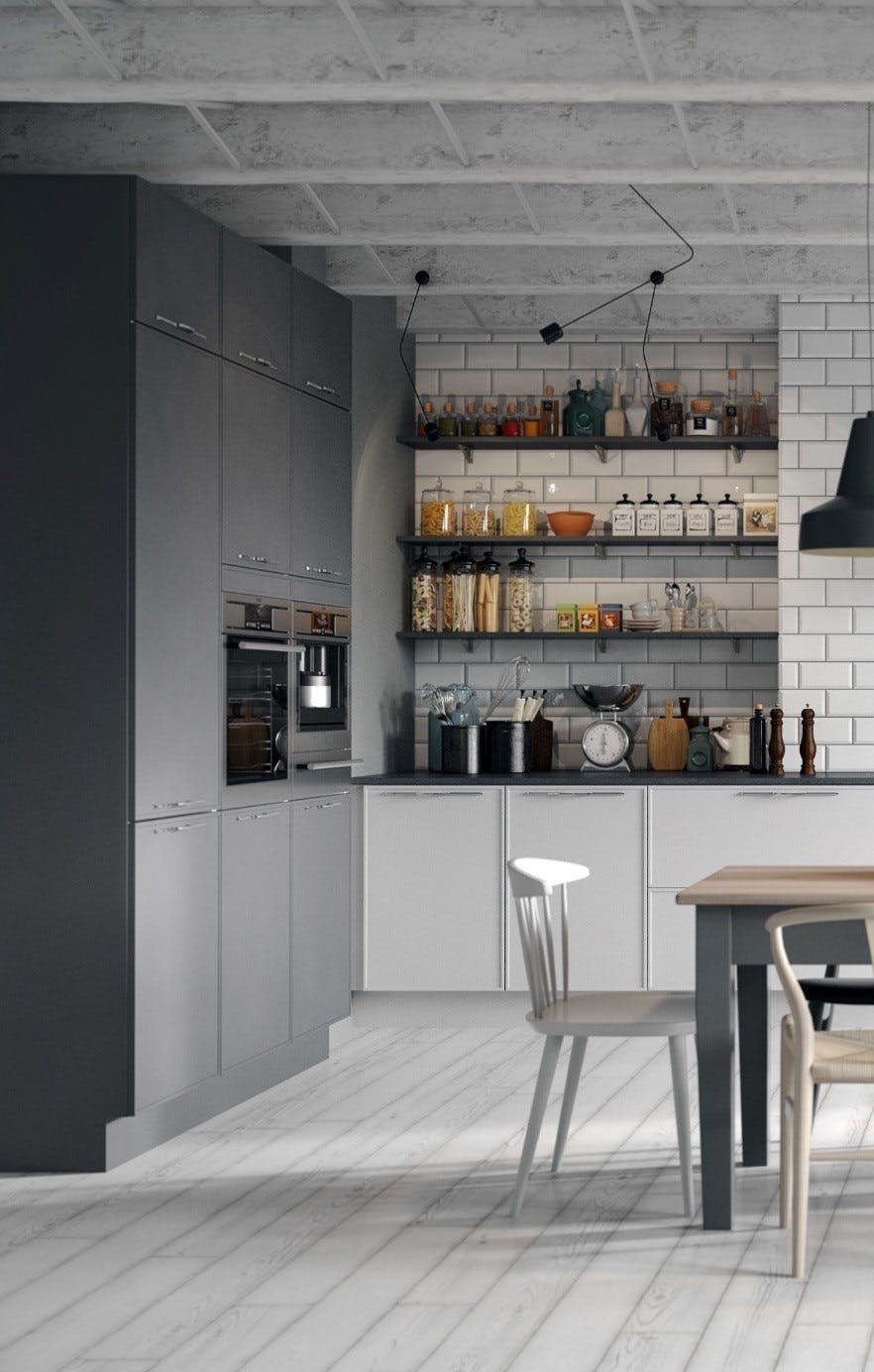
We mentioned the effect corner shelving can be used to display personality. Now let’s talk about open shelving.
Open shelving provides an attractive, modern look to the kitchen and allows for easy access to frequently used items, while also making the kitchen appear larger. In the L-shape layout, open shelving can be used to break up the monotony of the limited wall space, creating an interesting and eye-catching design.
Additionally, open shelving creates the opportunity to incorporate decorative elements, such as colourful dishes or cookbooks, that can add personality to the kitchen.
5. Add charm with a farmhouse sink
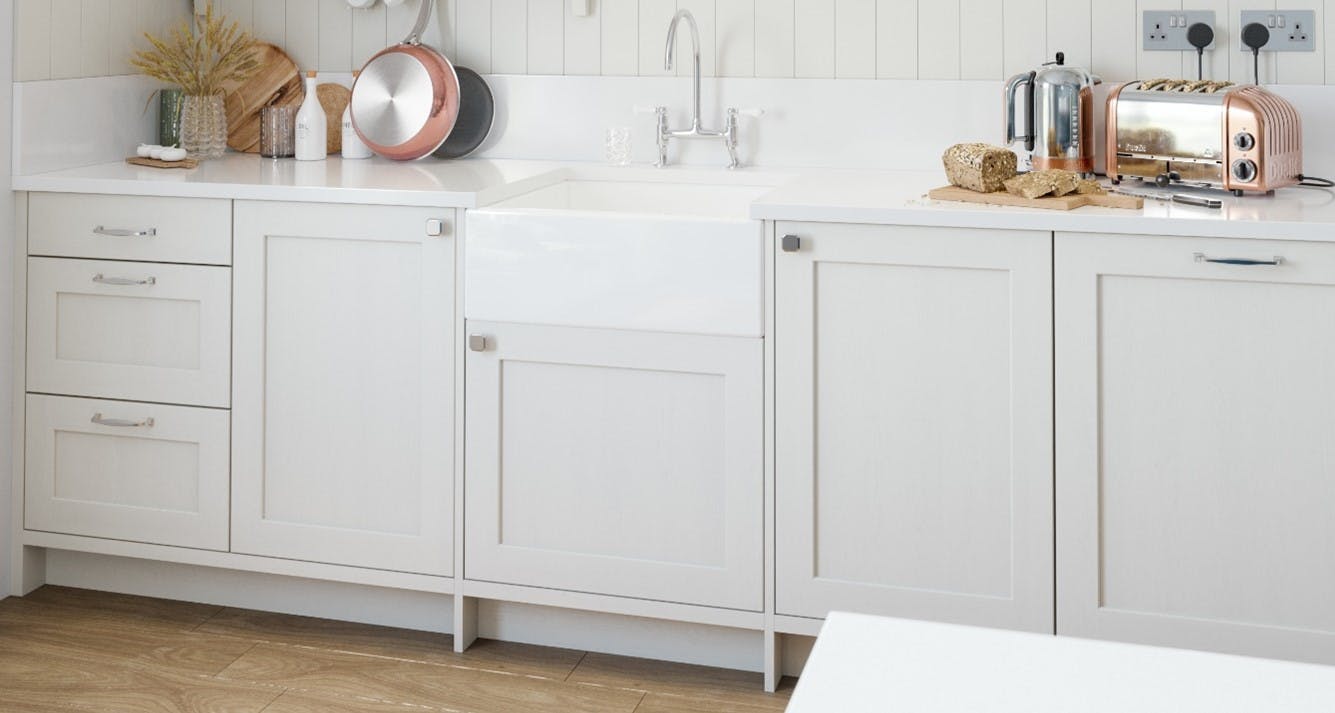
6. Use lighting to create a cosy space
Lighting can be used to draw attention to the features that matter most, such as countertops, backsplash, and cabinets.
The right lighting has an innate ability to create a wholesome and cosy atmosphere in the dining room, and by strategically placing and using lighting in an L-shaped kitchen, you can create a beautiful and inviting space that will make it easier to work, entertain, and enjoy.
7. Add sophistication with a wine rack or cooler

Wine isn’t just for drinking. It’s also there to be shown off, right?
Wine racks are a great statement piece and bring a touch of sophistication to the kitchen. Within the L-shaped kitchen design, the rack can be placed in the corner, helping to fill any awkward or unused spaces in an effective and striking way.
Additionally, wine coolers and racks are relatively inexpensive and easy to install, so they can be great solutions for budget-conscious homeowners.
8. Pull-out pantry units can make even the tightest space feel spacious
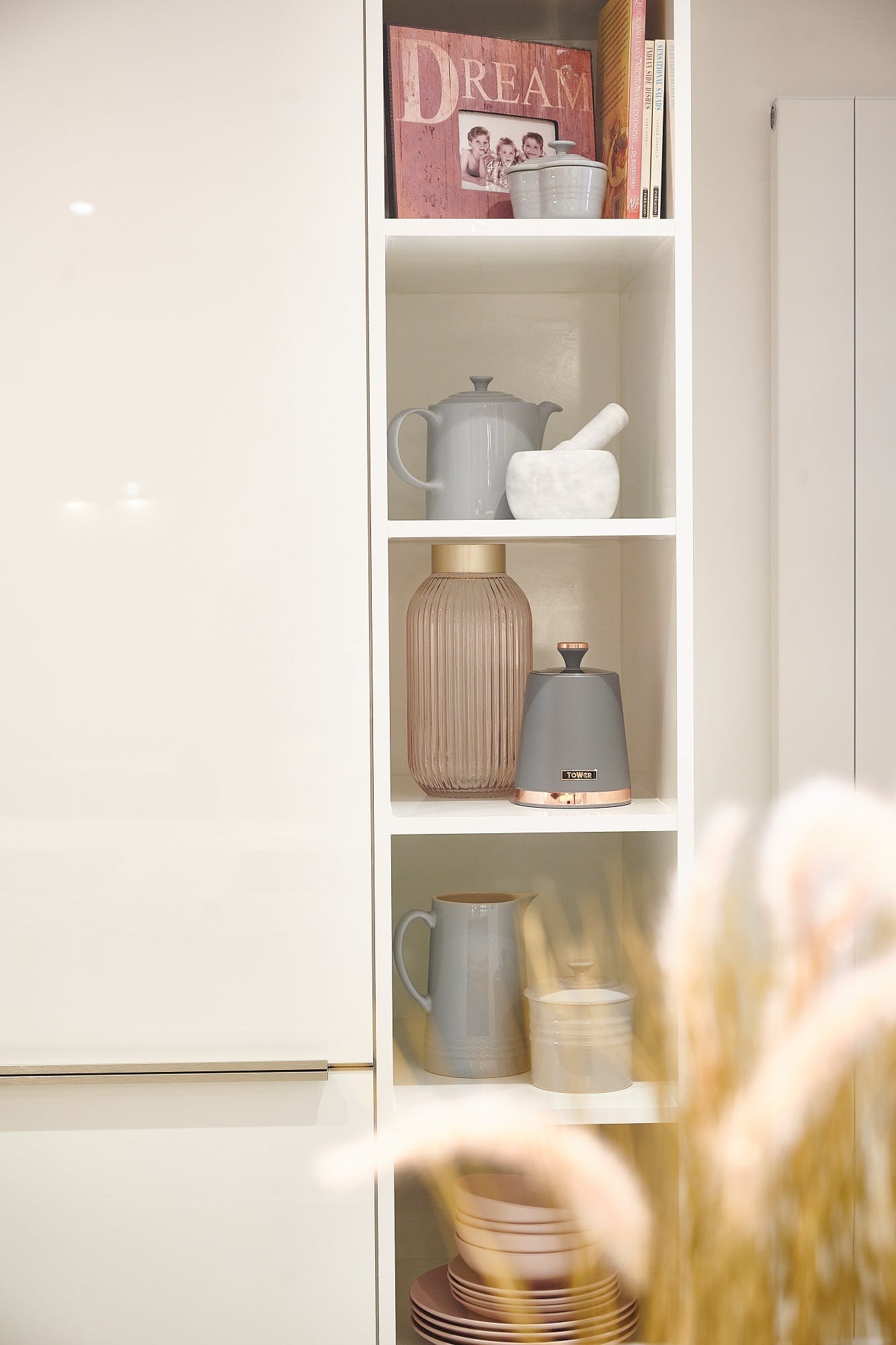
We’re back to functionality here.
The pull-out pantry will elevate the overall look and feel of a kitchen, keeping the space clean and organised, with all your stored items being just a pull of a handle away.
This is a great design tip for homeowners playing with limited space, allowing you to make the most of every inch of available space while retaining order and style.
9. Consider using textured materials and natural elements
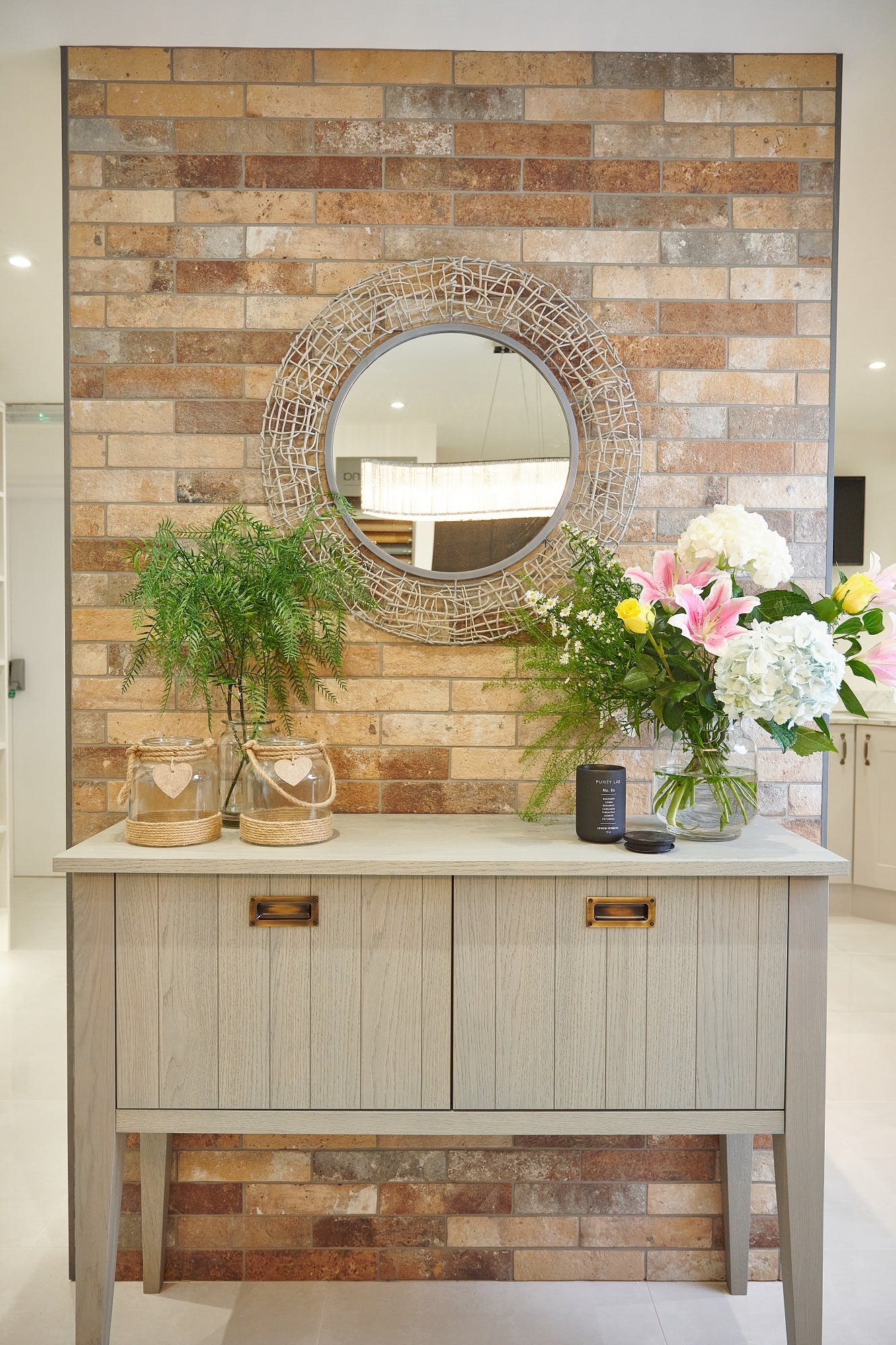
Textured materials can bring depth and dimension to the room, creating a stylish and inviting atmosphere, while reducing the impact of a kitchen’s hard lines.
Additionally, textured materials can help to hide any imperfections in the kitchen's surfaces, creating a more polished appearance. Within a tight L-shaped design, these textured materials can provide a subtle contrast to other elements and interesting designs.
Similarly, natural elements such as wood, stone, and plants bring a sense of warmth and texture that is difficult to replicate with synthetic materials. Additionally, natural elements can help soften the straight lines of an L-shaped kitchen, creating a more inviting and comfortable atmosphere.
Finally, if you’re planning a kitchen renovation, natural elements can also help to reduce the overall costs, given that they're typically more affordable than their synthetic counterparts.
10. Add a backsplash
If you’re looking to create a space that is both stylish and modern, a backsplash will do the trick.
Incorporating a backsplash will add texture to the room, draws the eye upward, and also add a pop of colour or pattern to the walls.
Easy to install and affordable, backsplashes bring a wow factor to the kitchen, all while helping protect walls from unnecessary water damage, grease, and food splatter. They’re a neat little touch to tie the entire kitchen together and make it look more unified.
Different styles of L-shape kitchen
We’re not done just yet.
While we have gone through some of the key design features you should consider as part of any L-shaped kitchen design, it is also worth noting that there are a few different variations of styles to consider.
After all, you want your kitchen to be a mirror reflection of your unique personality, so getting that style choice right is important.
Here are the five primary concepts to help guide you on your way…
Open-concept L-shape
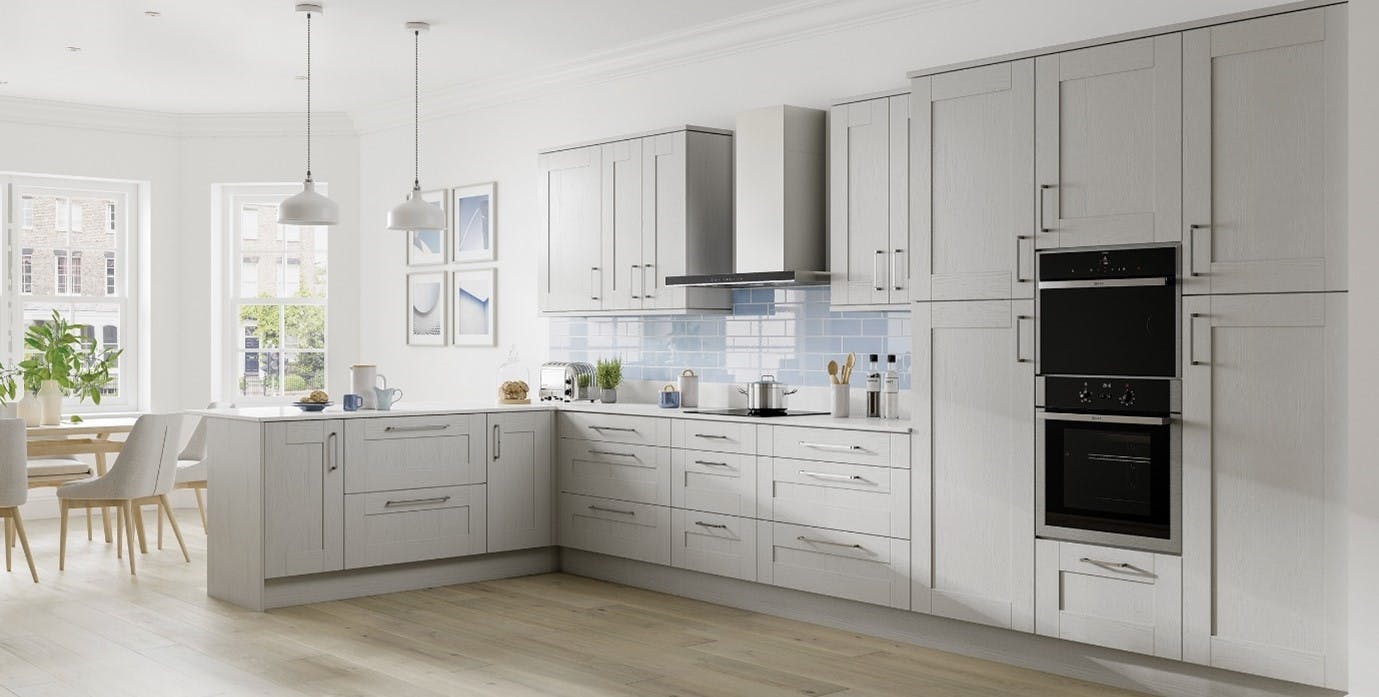
The open-concept kitchen allows for fluid movement from the kitchen to adjacent living areas, making it ideal for entertaining and everyday living.
Meanwhile, the L-shape configuration is ideal for maximising counter and storage space, as well as providing a comfortable and efficient workspace. With an open-concept kitchen, the cook can interact with guests in the living room or dining room while still being able to keep an eye on dinner preparations.
The open concept also allows for plenty of natural light, opening up the room and creating a sense of space. Additionally, the open concept provides increased access to the kitchen, making it easy to grab a snack or prepare a meal.
If you’re looking for a solution that will help make your kitchen the hub of the home, then look no further.
Farmhouse-inspired L-shape
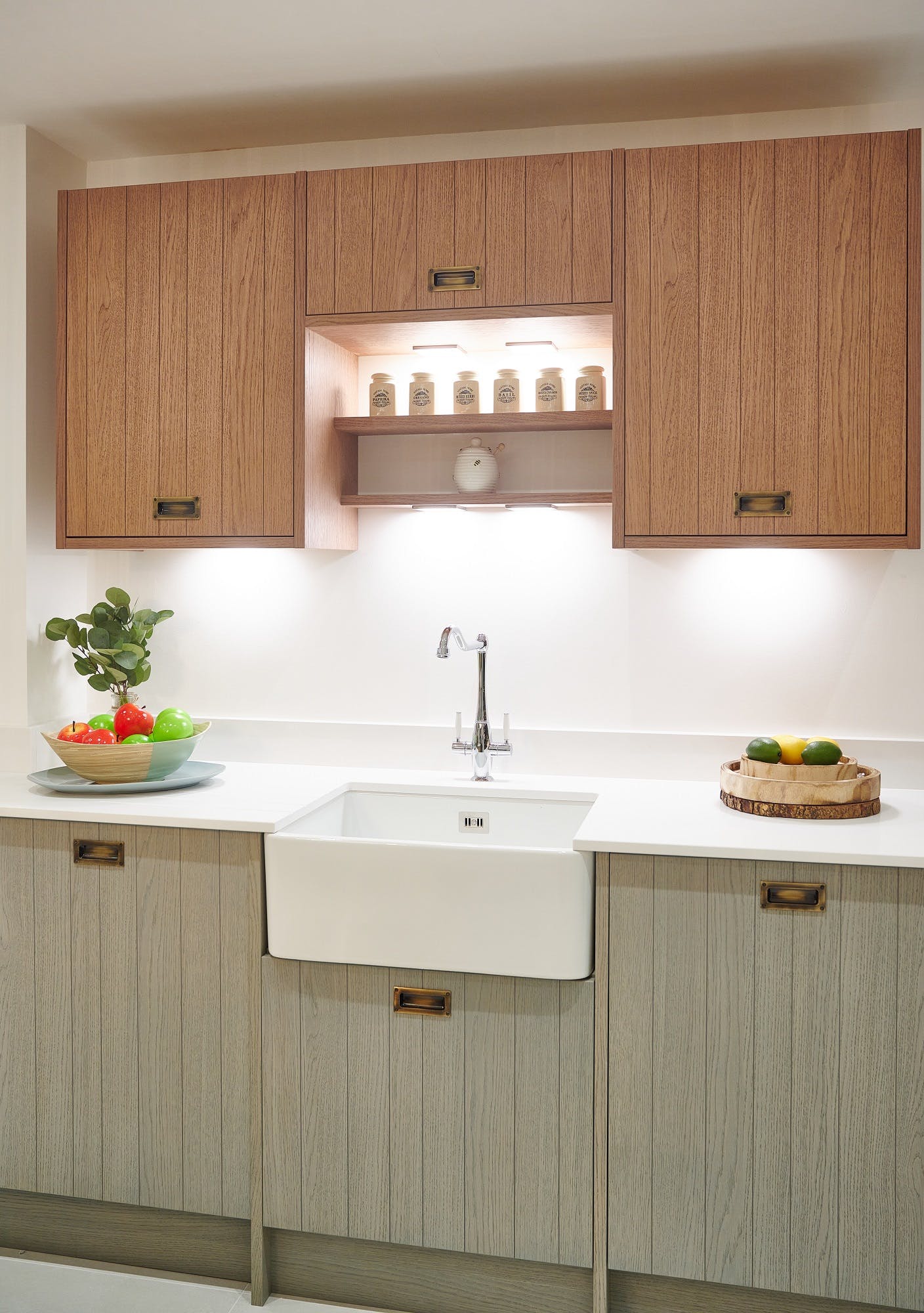
One of the most popular and timeless design trends is the farmhouse-inspired L-shaped kitchen.
Featuring a classic white and wood colour palette, the L-shaped layout of the kitchen allows for efficient cooking and entertaining, and the combination of open shelves and cabinets provides ample storage for all of your kitchen essentials.
The classic, rustic, and timeless feel of a farmhouse-inspired kitchen gives it an inviting atmosphere, perfect for gathering with family and friends. It is beauty and functionality packaged up in one room.
Additionally, this style is easy to customise and can be tailored to fit any budget and lifestyle.
Sleek and modern L-shape
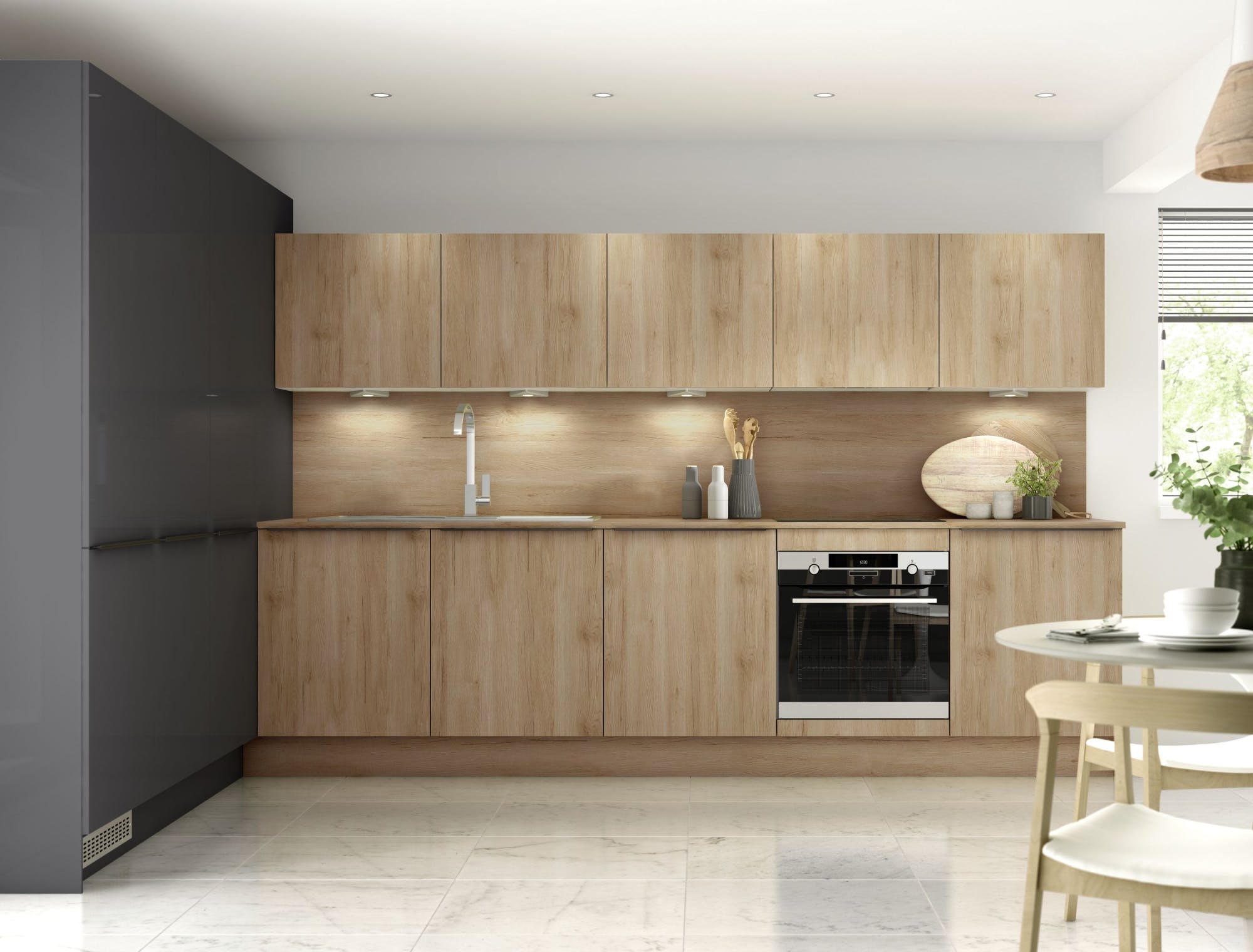
It’s obvious why the modern look appeals in today’s market.
Sleek modern incorporates clean lines, a light colour palette, minimal hardware, and modern materials such as stainless steel, quartz countertops, and glass.
For greater impact, you can add unique lighting fixtures and modern appliances. With the right design, a sleek and modern L-shaped kitchen can be created that is both stylish and functional.
Two-tone L-shape
Here, we’re talking about the use of colours and materials to create an eye-catching design and contrast.
Generally, the two tones are used to separate the kitchen into two distinct sections: the cooking area and the dining area. This can be achieved by using two different cabinet colours, materials, or finishes.
Alternatively, the same colour can be used for the cabinets, with a contrasting countertop or backsplash used to create the two tones. By mixing these two tones, you’re adding a modern flair to the overall design, making it look more luxurious and sophisticated.
Compact L-shape
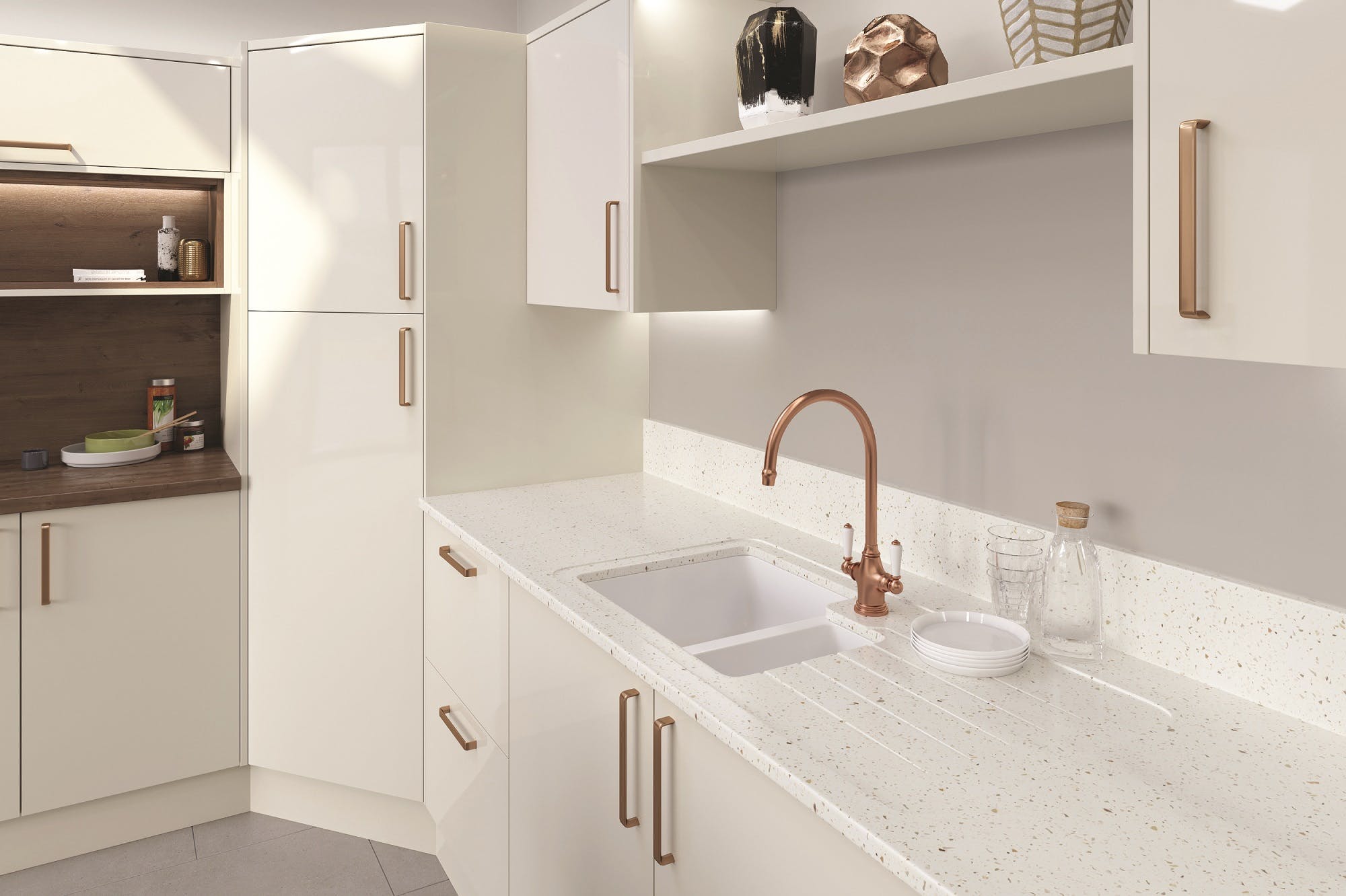
Not all kitchens are blessed with an abundance of space.
Some are limited and tight. But it doesn’t mean they can’t be made any less perfect or something you can’t be proud to show off. If this is resonating with you, the compact L-shaped design is the perfect solution as it maximises the use of corner space and provides an efficient workspace.
It is achieved by having two adjacent walls in a kitchen that are set at 90-degree angles. This layout allows for larger counter space and can accommodate several appliances. By adding an island to the layout, the kitchen can become even more efficient and provide more storage and counter space.
Furthermore, by using materials such as stainless steel, glass, and wood, the kitchen can be transformed into a modern and stylish room.
Can we help make your dream L-shaped kitchen a reality?
While we have provided 10 points of inspiration, the truth is you can mix and match a combination of our favourite L-shaped kitchen design ideas to achieve a look that is unique to you and how you want to use your kitchen,
For example, you could comfortably incorporate additional storage and a breakfast bar within your L-shaped kitchen. There’s also no reason why you couldn’t also increase the available work surface whilst adding additional storage, by adapting the rotational flow of the golden triangle to work with your kitchen design requirements.
At More Kitchens, we’re experts in all aspects of kitchen design and installation. Managing the entire project from start to finish, if you’re wanting to make an L-shaped kitchen the heart of your home, then call a friendly member of our team today or book a free design appointment with us today.
Similarly, though, if you’re not convinced after this that the L-shaped design is the right choice for you, you’ll find more inspiration with our Peninsula kitchen and open plan kitchen idea blogs.
Share this Post















.jpg?auto=compress%2Cformat&cs=strip&fit=clip&h=400&ixlib=php-1.1.0&w=400&s=d9e8d859b29a6de8754dd6be1637445f)
.jpg?auto=compress%2Cformat&cs=strip&fit=clip&h=400&ixlib=php-1.1.0&w=400&s=1ff3f28bcddfb6d8e51a1628aeac2a2e)
